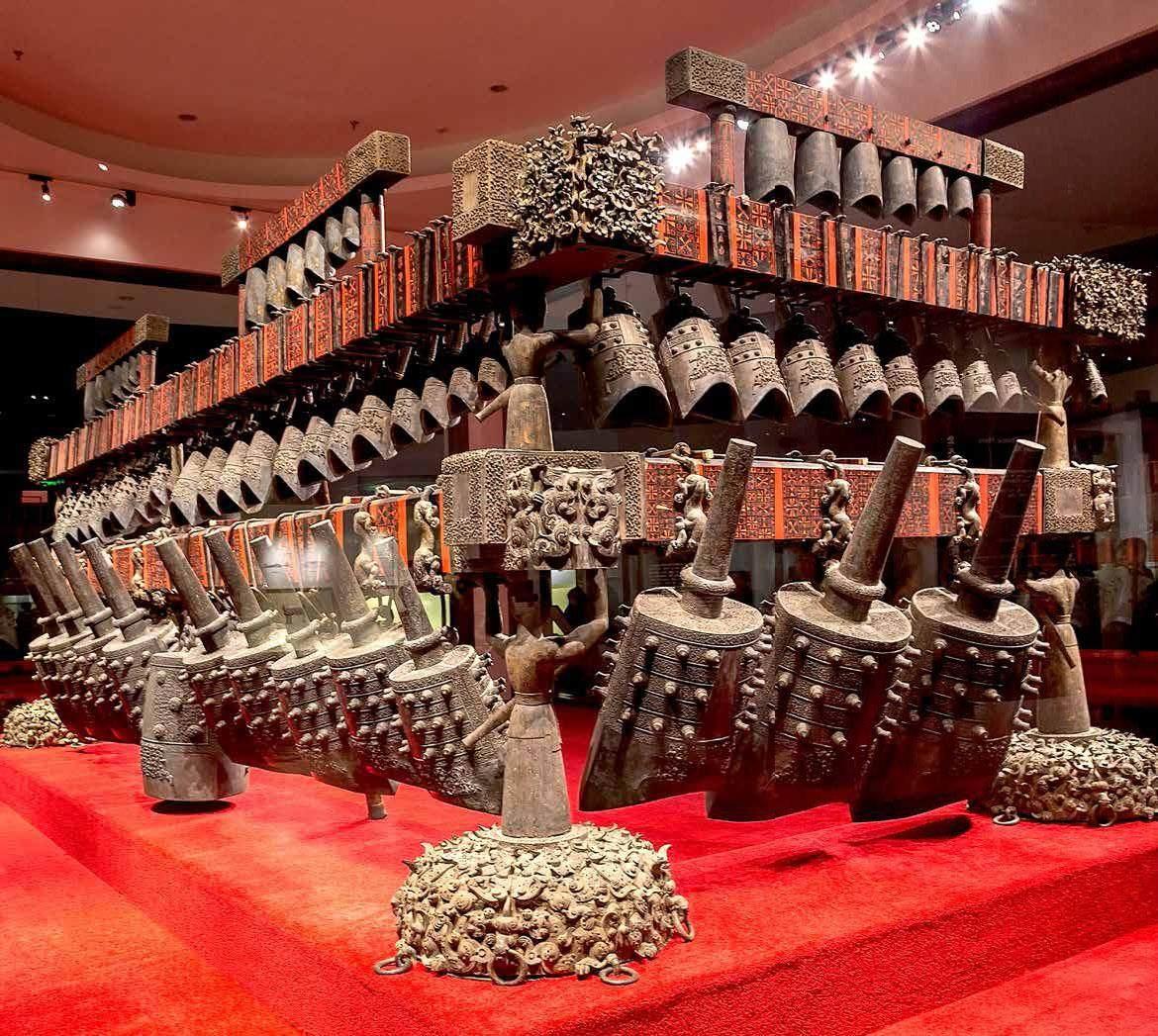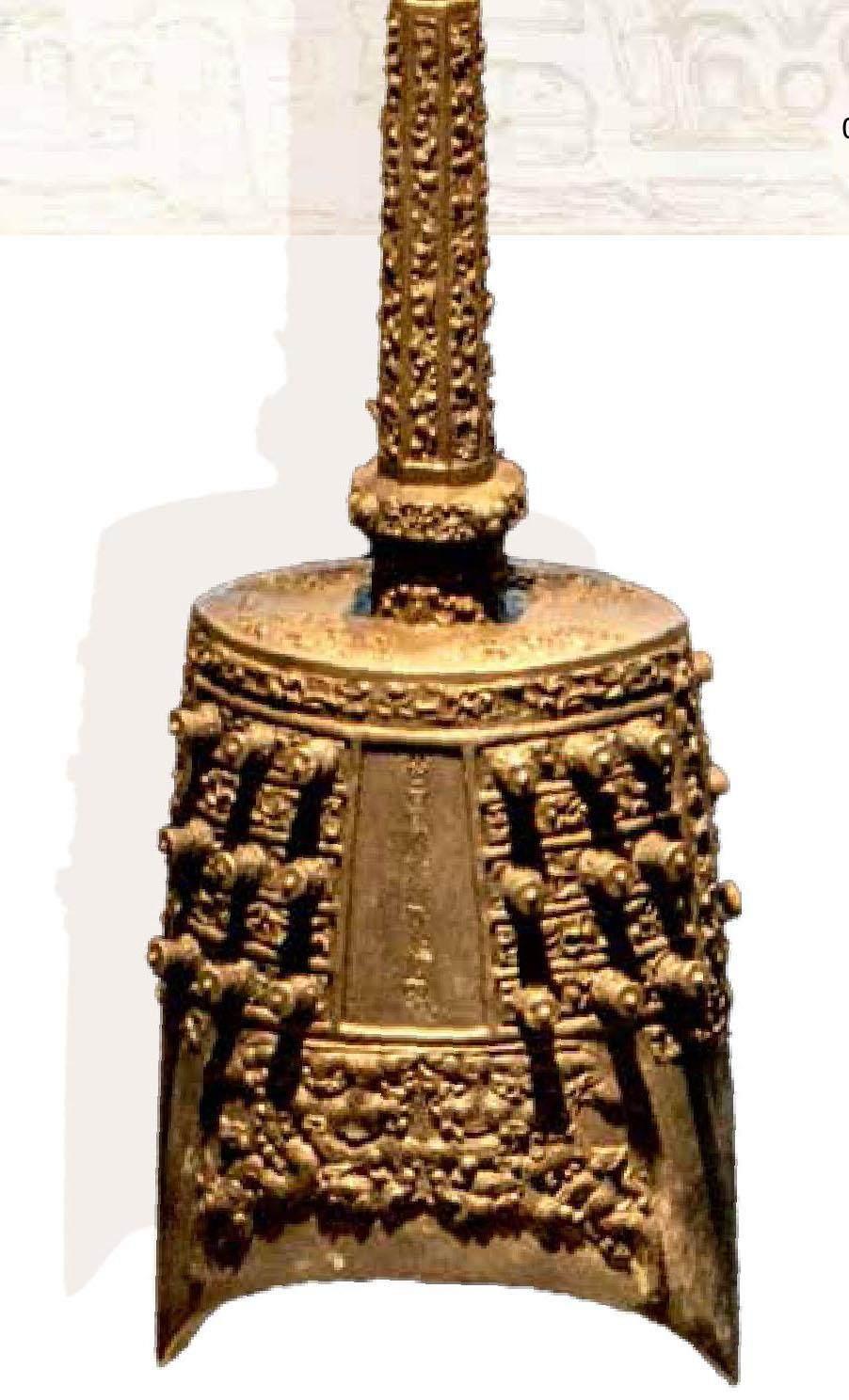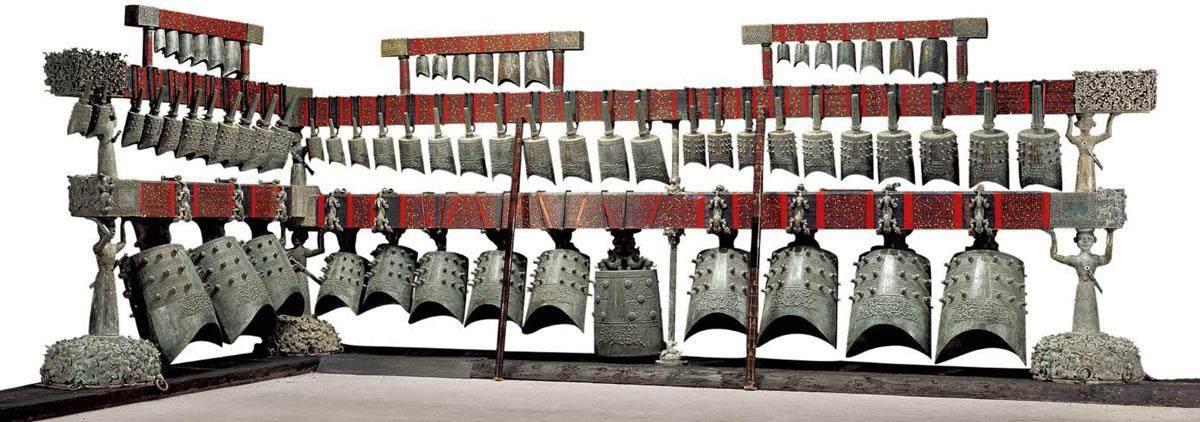曾侯乙编钟The Chime Bells in the Tomb of the Marquis Yi
胡昊Hu Hao



褐土之謎The Mystery of the Brown Soil
随州市位于湖北省中北部,省会武汉市西北方155公里处。1977年,随州的一处空军修理所准备在城关西北郊的一处丘陵地带建造营房。9月正式动工时,修理所副所长王家贵发现推土机下的泥土有些异样,中间的软土好似人为回填过。现场挖土方的施工人员挖到几块已腐朽成黑褐色的旧铜,随后就拿到废品回收站卖了。得知此事后,王家贵紧急召集大家,要求凡是挖到旧铜、铁、瓷器等,都一定要交到部队里。他强调:“这都是文物,任何人都不能拿走,拿走就是犯罪!”几天后,在离这片褐土东南面不远处,又相继挖出了四件旧铜器。
Suizhou is located in the central-northern partof Hubei Province, 155 kilometers northwest of theprovincial capital, Wuhan. In 1977, an air force repairshop in Suizhou was preparing to build barracksin a hilly area in the northwest outskirts of the city.In September, when construction officially began,the deputy director of the repair shop, Wang Jiagui,noticed something unusual in the soil beneath thebulldozer. The soft soil in the middle seemed tohave been artificially filled in. It turned out that theconstruction workers on site had dug up severalpieces of old copper that decayed into a dark browncolor and sold them to a scrapyard. Upon learning ofthis, Wang Jiagui urgently convened a meeting anddemanded that anyone who dug up old copper, iron,porcelain, or anything similar must turn it in to themilitary. He emphasized, “These are all cultural relics,and no one can take them away. Hoarding them isa crime!” A few days later, not far southeast of thisbrown soil area, four more old bronze artifacts wereexcavated one after another.
王家贵愈发觉得事有蹊跷,便先后两次把情况汇报给随县文化馆,但因现场勘查判定依据不足,两次上报后都无处理结果,“褐土之谜”一直未能解开。
Wang Jiaguis suspicions grew, and he reportedthe situation to the Suixian County Cultural Centertwice. Unfortunately, due to a lack of substantialevidence at the excavation site, both reports yieldedno results, leaving the “mystery” of the brown soilunresolved.
曙光初现Hope Dawns
1978年春节过后,当推土机推去颜色交错的红砂岩和青灰土,施工人员发现了一块长1.4米、宽1米的芝麻灰色花岗岩大石板,随即在附近又发现了好几块同类型的石板——这下施工现场热闹起来,显然这些石板是人为铺设的。于是,王家贵三访随县文化馆,终于请来了“诸葛亮”——副馆长王世振。王世振来到现场勘查后,分析认为,此处具备墓地条件:有墓坑,坑壁清晰,且有经过夯实的填土。但因墓坑太大又不规则,当时他也不敢妄下结论。随后,他将情况上报上级文化部门。经省考古专家的勘测与发掘,褐土之谜终于解开,曾侯乙墓也终于被揭开神秘面纱,展现在世人面前!
Shortly after the end of the Chinese New Year celebrations in 1978, while bulldozers were clearing away amixture of red sandstone and grayish-blue soil, construction workers stumbled upon a massive slab of sesamegraygranite, measuring 1.4 meters in length and 1 meter in width. They soon discovered several more similarslabs nearby, all clearly indicating human craftsmanship. The construction site buzzed with excitement as itbecame evident that these slabs were intentionally placed. At this point, Wang Jiagui made the third visit tothe Suixian County Cultural Center, eventually persuading Deputy Director Wang Shizhen, the museumsmost learned scholar, to assess the situation. After Wang Shizhens thorough survey of the site, he surmisedthat it possessed the characteristics of a burial site. He noted the presence of tomb pits with distinct walls andcompacted earth within them. However, owing to the irregular and substantial size of the tomb pit, he refrainedfrom drawing premature conclusions. Subsequently, he reported the situation to higher cultural authorities,leading to an investigation and excavation carried out by provincial archaeological experts. Finally, the enigmaof the brown soil was unraveled, revealing the Tomb of Marquis Yi of Zeng State to the world.
一钟双音The Chime Bell with Dual Sounds
两个月后,墓坑里的积水几近抽净,曾侯乙编钟露出水面,震惊考古界。整套编钟由制式不同的钮钟、甬钟和镈钟组成,共65件。青铜钟大小渐次,相编而成,分为三层八组,悬挂在呈曲尺形的彩绘铜、木结构的钟架上;而支撑这座“庞然大物”的仅仅是六个青铜武士和八根小圆柱。这是中国现存规模最大、重量最重、音乐性能最好的一套编钟,堪称“编钟之王”。
Two months later, as the water in the tomb pitgradually receded, the chime bells made a stunningappearance, sending shockwaves through the worldof archaeology. This extraordinary set of bellscomprises 65 pieces, including Niu bells, Yong bells,and Bo bells, each with a unique shape and size.These bronze bells, organized in descending order ofsize into three tiers and eight groups, are suspendedfrom a curved wooden frame adorned with paintedbronze decorations. Surprisingly, this monumental ensemble is supported by merely six bronze warriorstatues and eight slender columns. It stands as thelargest, heaviest, and most sonorous set of chimebells in all of China, rightfully earning the title of the“King of Chime Bells.”
曾侯乙编钟最为神奇的地方是其“一钟双音”:按照钟体上的标音铭文所示,分别敲击钟的正鼓部和侧鼓部,同一件钟可以发出两个不同的乐音,而且两个乐音之间呈三度的和谐音程关系。比如,中层三组第五号钟,其正鼓部标音为“羽”,侧鼓部标音为“宫”,意思是分别敲击,就可以发出la和do 的音。
What truly distinguishes these bells is theirunique dual sounds: based on inscriptions on thebells, ringing the front and the side of each bellproduces two distinct musical sounds with threedegrees interval between them. Take the fifth bell in the middle tier for example: its front section bears theinscription 羽, while the side section is marked with宫, indicating that they give off the musical notes “la”and “do” respectively.
那么,这“一钟双音”的奥秘究竟是什么呢?《梦溪笔谈》中有记载,先秦时期“ 古乐钟皆扁,如合瓦”。所谓“合瓦”,是说钟的形状如两片瓦合在一起。当敲打这种合瓦形钟体时,钟体两侧的棱部进入振动状态会对钟声起到阻尼作用,也可以避免编钟所发乐声过长而相互干扰。敲击同一编钟的不同部位时,就出现了一钟双音现象。
What exactly produces the dual sounds of thesebells? The Dream Pool Essays reveal that before thepre-Qin period, ancient musical bells were “shaped flatlike two fused tiles.” This term describes their shape astwo semicircular tiles joined together. Striking thesebells causes the edges on both sides to vibrate, whichdampens the sound and prevents interference betweendifferent tones when struck at various points. Thisunique structural feature is what enables the bells toproduce their distinctive dual sounds.
編钟的音色也受其材质的影响。曾侯乙编钟的青铜合金经检测为锡青铜,并含少量的铅。研究表明,不同金属的配比会影响编钟的音色。含锡量为13% ~ 16%,音色就会浑厚丰满,而曾侯乙编钟的含锡量是13%左右,使得音色恰到好处、悦耳动听。此外,含铅量过大,就会对音色产生不良影响。曾侯乙编钟的含铅量为1.2% ~ 3%,既保持了钟声的衰减速度以适应演奏的需要,又保持了音色的和谐。
Furthermore, the material of a chime bellsignificantly influences its tone. The alloy used inthese bells has been analyzed as tin bronze with aminor trace of lead. Research show that the ratio ofdifferent metals can affect the tone of chime bells.With a tin content ranging from 13% to 16%, thebells produce a rich and resonant tone, while atin content of approximately 13% results in a tonethat is perfectly balanced and pleasing to the ear.Additionally, an excess of lead content can negativelyimpact the tone quality. The lead content of the chimebells in the Tomb of Marquis Yi, which ranges from1.2% to 3%, not only maintains the desired decayrate of their sounds but also preserves the overallharmony of the tones.
要使一件钟发出两个不同的乐音,并且保持三度的音程关系,除了合瓦形的钟体,还需要技术上的调音和调律。曾侯乙编钟的钟体内壁上有凸起的音塬(yuán)和凹陷的音隧,并且大多经过了研磨和刮削,这些便是当年工匠们留下的调音、调律的痕迹。一钟双音是中国乐器的伟大发明,它诞生于青铜和火焰之中,植根于文明,成熟于礼乐。这是古人几千年来不断探寻钟铃乐器发音规律、磨炼铸钟技术的结果。
Achieving two distinct musical notes from asingle bell while maintaining three degrees of intervalin between is not solely attributed to the bells fusedtile shape; it also necessitates meticulous technicaltuning and tempering. Inside the body of each bell,one can find raised sound platforms and recessedsound tunnels, many of which bear the marks ofgrinding and scraping. These are the telltale signs leftby skilled artisans during the tuning and temperingprocess. These dual-tone bells represent a magnificentinvention in Chinese musical instruments. It wasborn from the elements of bronze and fire, rooted inancient civilization, and refined through the mediumof ritual music. This remarkable innovation is theculmination of millennia of exploration into theprinciples of bell sound production and the masteryof bell-casting technology by Chinese ancestors.
千古绝响Echoes Through the Ages
曾侯乙编钟自出土以来,仅公演三次。Since the discovery of these chime bells from theTomb of Marquis Yi, they have graced the public withtheir melodies on just three occasions.
出土后三个月,经复原组装、保护处理后,曾侯乙编钟以《东方红》为开篇,第一次向世人发出它那雄浑的千古绝响。
Their grand debut took place a mere threemonths following their excavation and restoration,when they were used in the beginning section of thesong “The East is Red.”
中华人民共和国成立30周年之际,在北京举办的“湖北随县曾侯乙墓出土文物展览”上,曾侯乙编钟原件展出并现场演奏,这是它第一次且唯一一次离开湖北省博物馆,也是它的第二次奏响。
To mark the 30th anniversary of the foundingof the Peoples Republic of China, an exhibitionwas held in Beijing to display the artifacts from theTomb of Marquis Yi. On this occasion, the bells wereshowcased and played live. This marked not onlytheir second appearance but also their sole departurefrom the Hubei Provincial Museum.
1997年香港回归,在中英政府的香港交接仪式现场,来自世界各地的数千名嘉宾欣赏了由著名音乐家谭盾创作并指挥、用曾侯乙编钟原件采音录制的《交响曲1997 :天 · 地 · 人》。曾侯乙编钟第三次向世人展现了它的無穷魅力。
In 1997, during the historic handover ceremony of Hong Kong from Britain to China, thousands ofdistinguished guests from around the globe had the privilege of enjoying “Symphony 1997: Heaven, Earth,Mankind,” composed and conducted by the renowned musician Tan Dun. In this performance, the chime bellswere used for recording, revealing their allure to the world for the third time.
与现代钢琴相比,整套曾侯乙编钟的音域跨五个半八度,中心音域内12个半音齐备,可以用来演奏古今中外名曲。时至今日,湖北省博物馆利用曾侯乙编钟复制件,仍延续着那来自千年前的动听音韵。
Compared to modern pianos, the chime bells in the Tomb of Marquis Yi make all the 12 semitones in fiveand a half octaves within the central range, allowing them to perform famous music from different times andplaces. Today, the Hubei Provincial Museum continues to reproduce these iconic bells, preserving and carryingforward the enchanting melodies of a bygone era.

